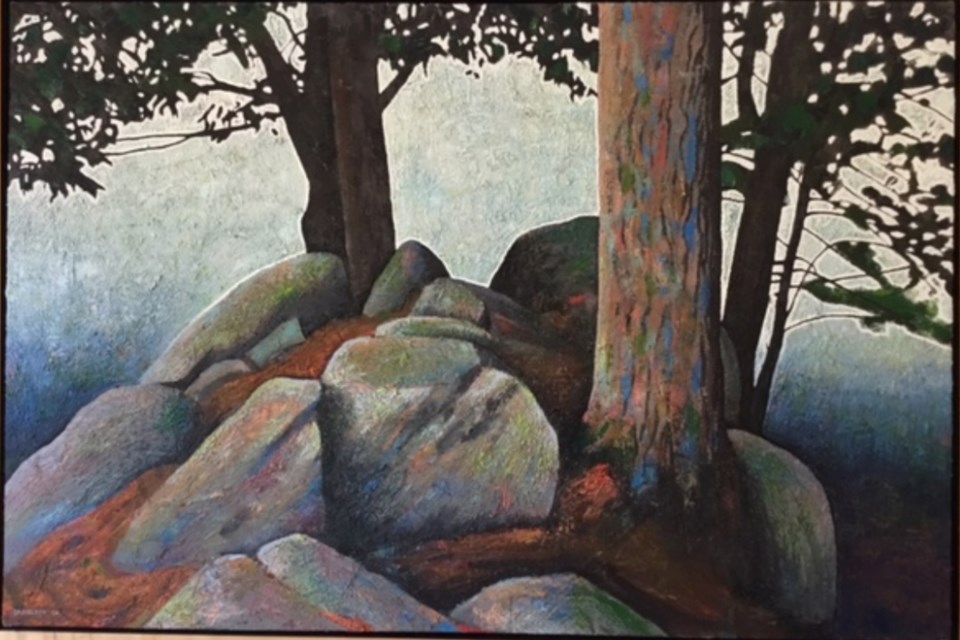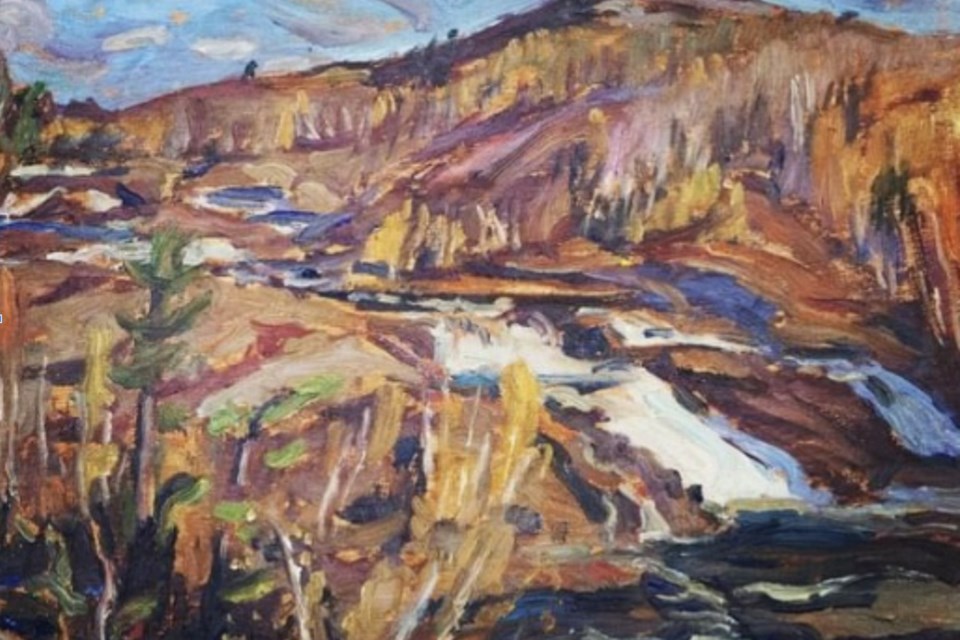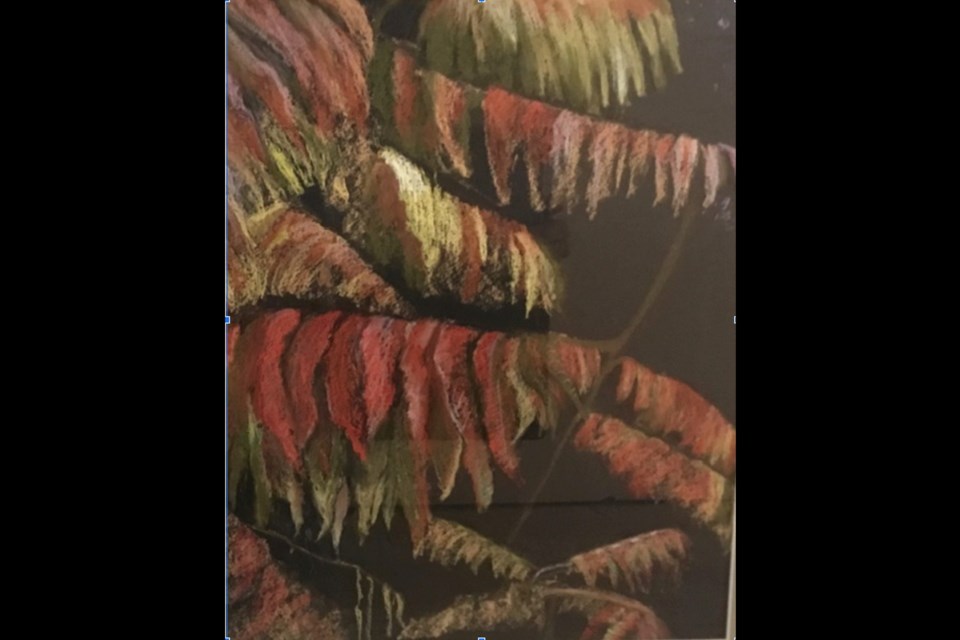State of The Arts Sudbury
newsletter/blogs Aug 13, 2024

Here is a great article written by one of our Board members of the Sudbury Arts Council Dieter Buse. My recent blog list the many Galleries and Art installations in Sudbury worth visiting.
State of the Arts: Celebrating Sudbury’s visual artists

Culture exercises the mind, the emotions, and sometimes, the body.
Paintings or prints by many artists, most of whom are local, decorate my house. Frank Danielson’s big canvas of two large trees emerging from what could be seen as a Calvary of rocks in front of a light blue sky reflects both the solidity and ethereal aspects of our region.
Nearby is a Carenie Little painting featuring the head of a woman with big eyes and stark black hair. The head fills the whole frame as she exudes Spanish aristocracy.
n the bathroom is a small painting of a man with an umbrella walking away from the viewer. Paulette Stewart usually does landscapes, but here she has abstracted a person against a red background.
Near the sunroom is a painting that I immediately recognized as a beautiful rendition of a favourite spot at the end of the hiking trail on George Island at Killarney. Joan Chivot has captured the tones of the lichen on the orangey-pink rocks.

In the hallway is a print by Nellie Keillor Lowe depicting in soft browns the contours of houses of a mining town zig-zagging over hills.
All these creators have Sudbury and technical excellence in common. I own other local and regional art bought on the principle that we should support regional creativity.
Luckily, the Sudbury area is strong in the visual arts of painting, installations, prints and experimenting with visual forms.
One regional artist from Manitoulin whose work I encountered and appreciated before he became widely known was Leland Bell (whose Anishnaabe name is Bebaminojmat, which means “when you go around, you talk about good things”).
Later my wife gifted me a small one of his early works with his readily identifiable stylized Indigenous persons. I remain proud that I had a small part in getting his very large painting of seven sacred fires, that hangs above the entrance to the auditorium at Laurentian University, purchased through the former Gauthier gallery. The Art Gallery of Sudbury presently has an exhibit of his paintings.
Mentioning Nellie Lowe leads to the famed Group of Seven. She painted with them, as did Bruno Cavallo who captured so many Sudbury street scenes. Well known in Sudbury is that A. Y. Jackson did paintings of High Falls north of Chelmsford. Two of his landscapes were stolen from Sudbury Secondary School. A play by Judi Straughen explored the unsolved mysteries.
The family of another Group of Seven member, Franklin Carmichael, gifted many of his works to the Art Gallery of Sudbury, resulting in the future renaming of the gallery in his honour.
That gallery has a superb collection representing local, regional and national treasures. In addition to numerous Group of Seven examples, the gallery holds a very good selection of Canadian Inuit prints. Those were obtained when Pam Krueger served as director of what was then called the Laurentian University Museum and Art Centre.

For decades, the Art Gallery of Sudbury has provided a service to the area by featuring expositions not only of national artists such as Carmichael but regional achievers, including Ivan Wheale (Manitoulin), Heather Topp (feminist installations, recently acknowledged by being included in a New York special exhibit) and Daphne Odjig (Manitoulin).
The gallery has been located in the Bell Mansion, held in trust since 1969 by Laurentian University. Its art educational programs continue to foster interest in art and dispense knowledge and skills.
Ann Suzuki can represent the many dedicated volunteers who served on its board. She was an accomplished silk screen artist whose scarves were known for aesthetic colour combinations.
When I served with her on the gallery board during the 1990s, some of us pushed to have more local art recognized, which was done with exhibits as well as sales in the gallery shop. The gallery and shop have temporarily relocated to 172-174 Elm due to structural issues with the Bell Mansion.
Recently, the annual juried show “Emergence” was at the temporary location. It highlighted what high school students produce; art that is imaginative and of high quality.
The Art Gallery of Sudbury is not the only public visual arts organization in town. La Galerie du Nouvel-Ontario (GNO) is an artist-run centre that has long served Francophone artists and communities. Now located in Sudbury’s visionary Place des Arts, GNO is one of Northern Ontario’s preeminent centres of contemporary installation art.
It invites submissions from artists across Canada and presents a novel annual fundraiser, Le Nouveau Louvre, in which much art is crammed into a limited space with all pieces sold at one price.
Another small public gallery run by volunteers is at the Steelworkers’ Hall on Brady Street. Gallery 6500 has had exhibitions for nine years, all dedicated to social themes. Making us see our community from a critical perspective, this gallery has not shied away from themes such as personal confessions, homelessness, industrial landscapes, Indigenous women, Oryst Sawchuck’s urban themes, students’ views of COVID, political posters, and women working at Inco during wartime.
Among the regional artistic expositions and sales, the annual (in its 49th year) La Cloche shows are held at Whitefish Falls in early July. They are popular with creators from Sudbury and Manitoulin districts.
Each show features one “distinguished” artist among the dozens shown. This year, Martin Kotyluk of Sudbury is highlighted. Visual art there includes painting, prints, sculpture, stained glass and photography.
Similarly, the Perivale Gallery on Manitoulin Island near Spring Bay uses a broad definition of visual arts, to display and sell a selection of highly regarded regional artists, including many from Sudbury. The gallery is in a charming lakeside setting of gardens and woodland.

As in dance, clubs are crucial to the visual arts. Sudbury has several, including the large Sudbury Art Club (nearly 100 members) and the Walden Art Club.
The Sudbury club offers members paint evenings twice a week plus workshops. Local artists are often members of both organizations so as to exhibit at their semi-annual displays and sales. The quality at such shows varies as much as the diversity of styles and content. Self promotion and art promotion go hand in hand, which is not a negative but a necessary trait for those in cultural enterprises.
Getting artistic creations out to the public has always been difficult. Various collective approaches seek to help. Among the largest is the Northern Artists Gallery. Adeptly using social media, regional photographers, sculptors, painters, carvers, stained glass workers and designers can publicize high-quality images of their work. Their website is practical and tasteful, introducing the artists with a short bio and providing examples and prices of their work. The Northern Ontario Art Association serves a similar purpose but covers a wider region.
Small private galleries come and go, but the plucky riskers are to be commended for their efforts. At present, Amberhill Gallery and Gift Shop on Kathleen sells a mix of pottery, paintings, cards, essences, puzzles and prints. Owner Sarah Moreau is a fibre artist. More focused on painting, including her own work, is Carmen Martorella’s gallery Art and Soul on Baker Street. She features other artists on a rotating monthly basis.
The Stopciati Art Gallery on Applegrove Street features prints and reproductions as well as offering custom framing. The owner-artist, John Stopciati, often utilizes Manitoulin scenes in his work.
Gillian Schultze, a fabric and landscape artist, has a small gallery in the Cedar Point Plaza. Full Circle Art does pop up venue sales, at present in Elm Place, as does the Northern Artists Gallery in Plaza 69. The newest offers different quirky fare at Mindmelt Gallery (Cute and Creepy Art) on in the Elm Place mall downtown.
The art scene in Sudbury includes many self-taught artists who offer instruction and classes, regardless whether they have succeeded in juried shows, namely exhibitions that are reviewed by professional artists, or are recognized by work in major galleries.
With artistic creations, style and format are important, hence I acknowledge my own bias and preference for technical excellence. Many more names of Sudbury’s multitude of artists could have been offered but l simply conclude: the quality and quantity of local art is high, so support your local creators.
Dr. Dieter K. Buse is professor emeritus, History, Laurentian University. He is writing a series of columns on local culture and history on behalf of the Sudbury Arts Council.
